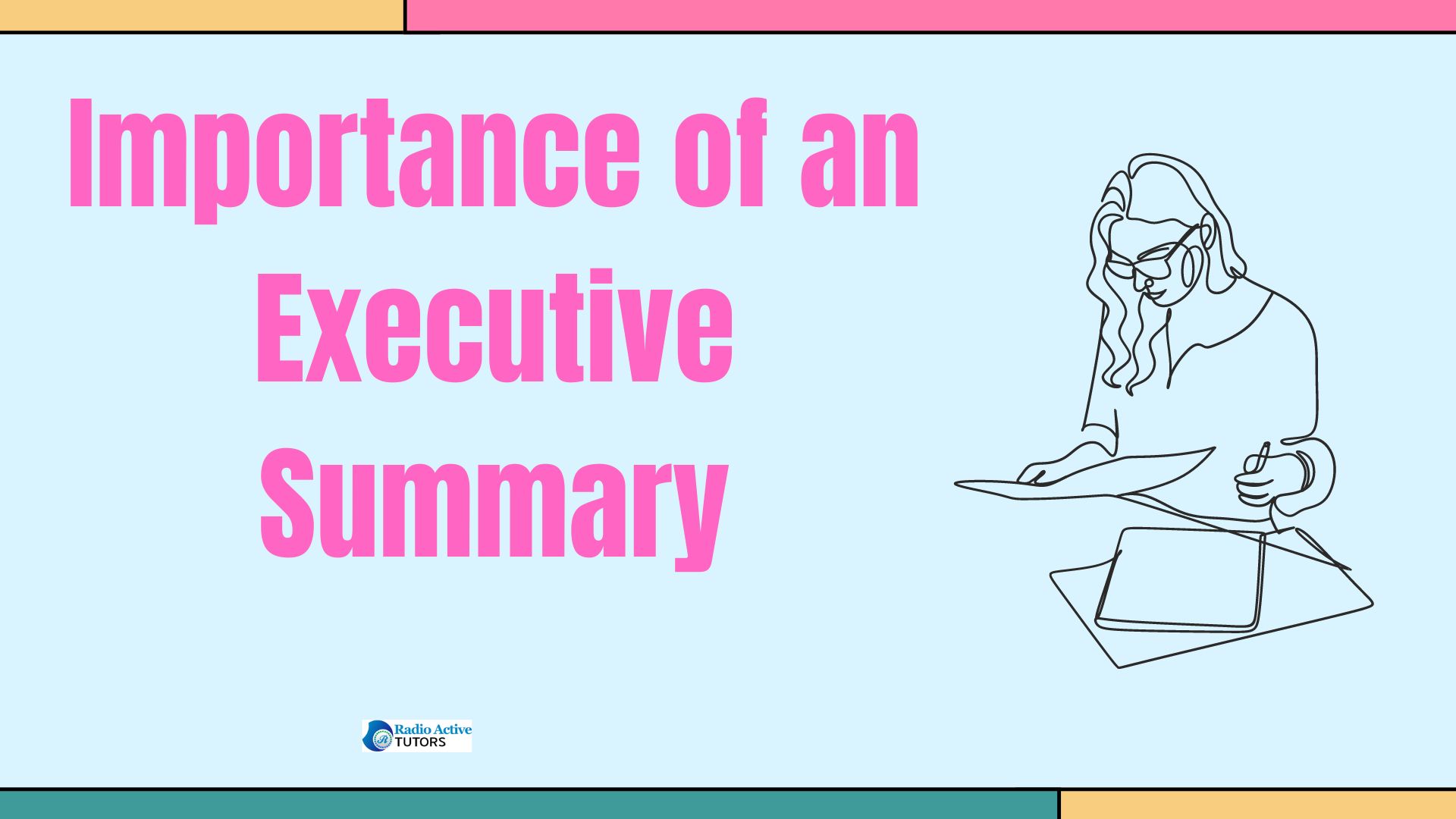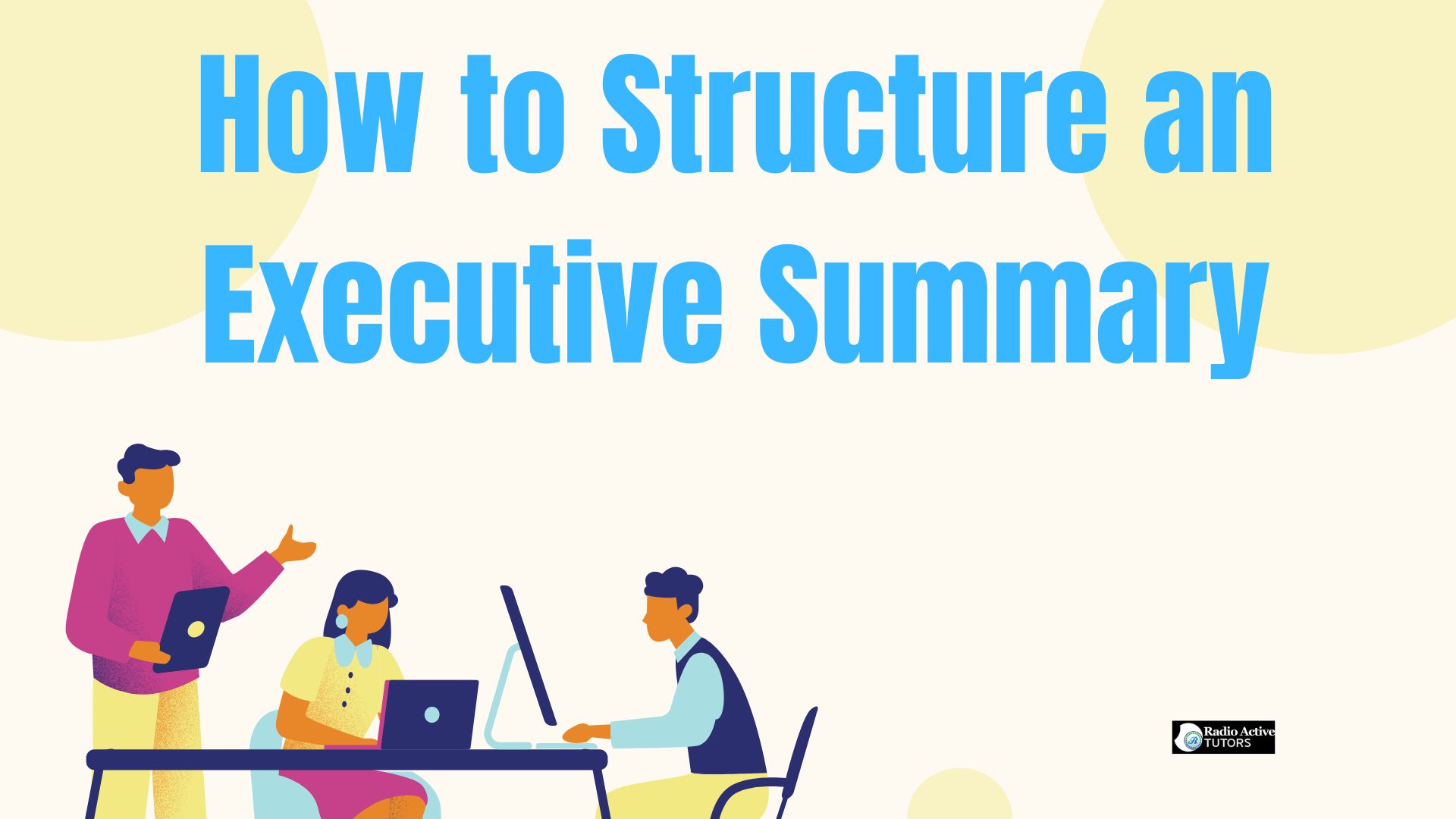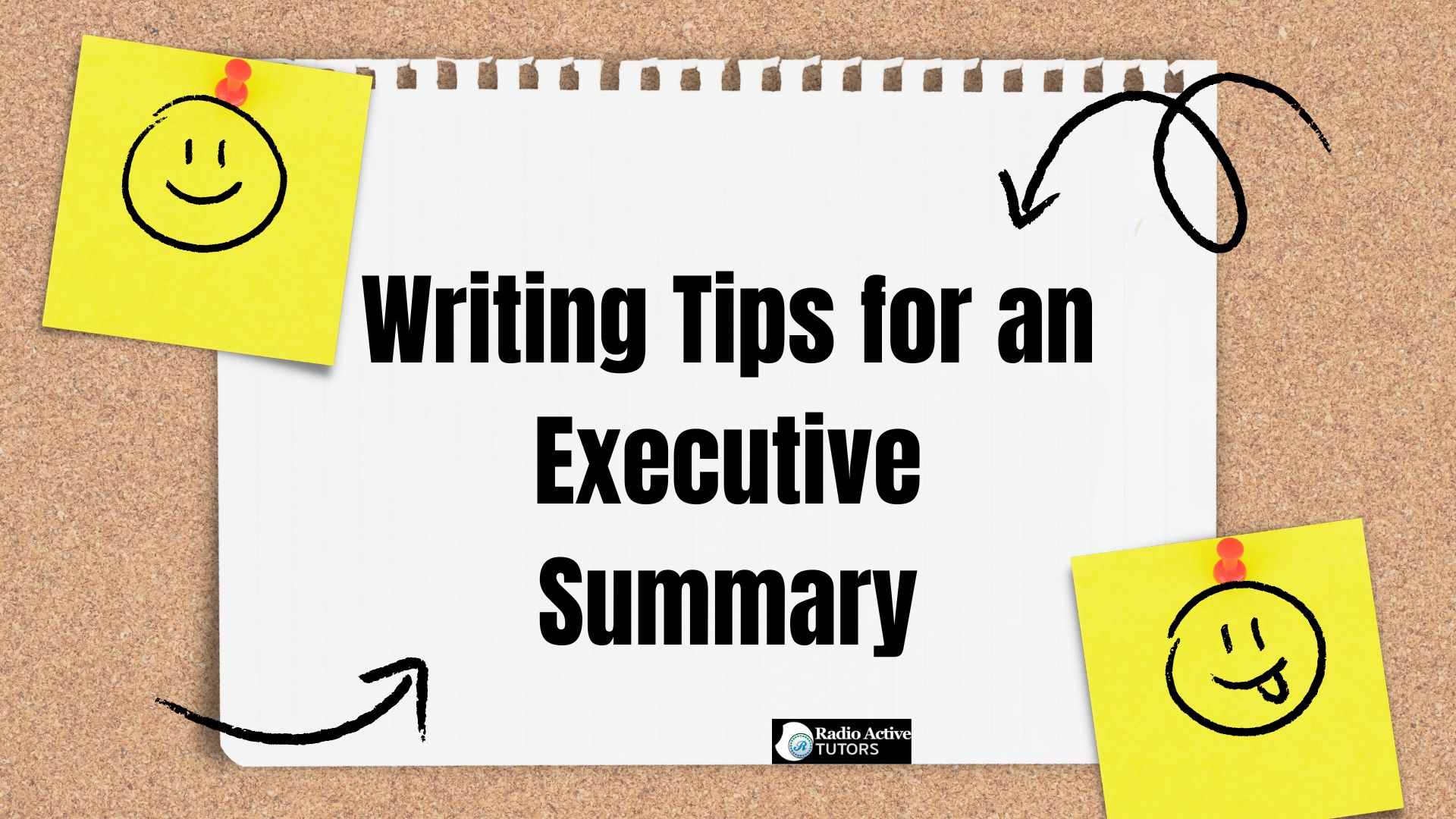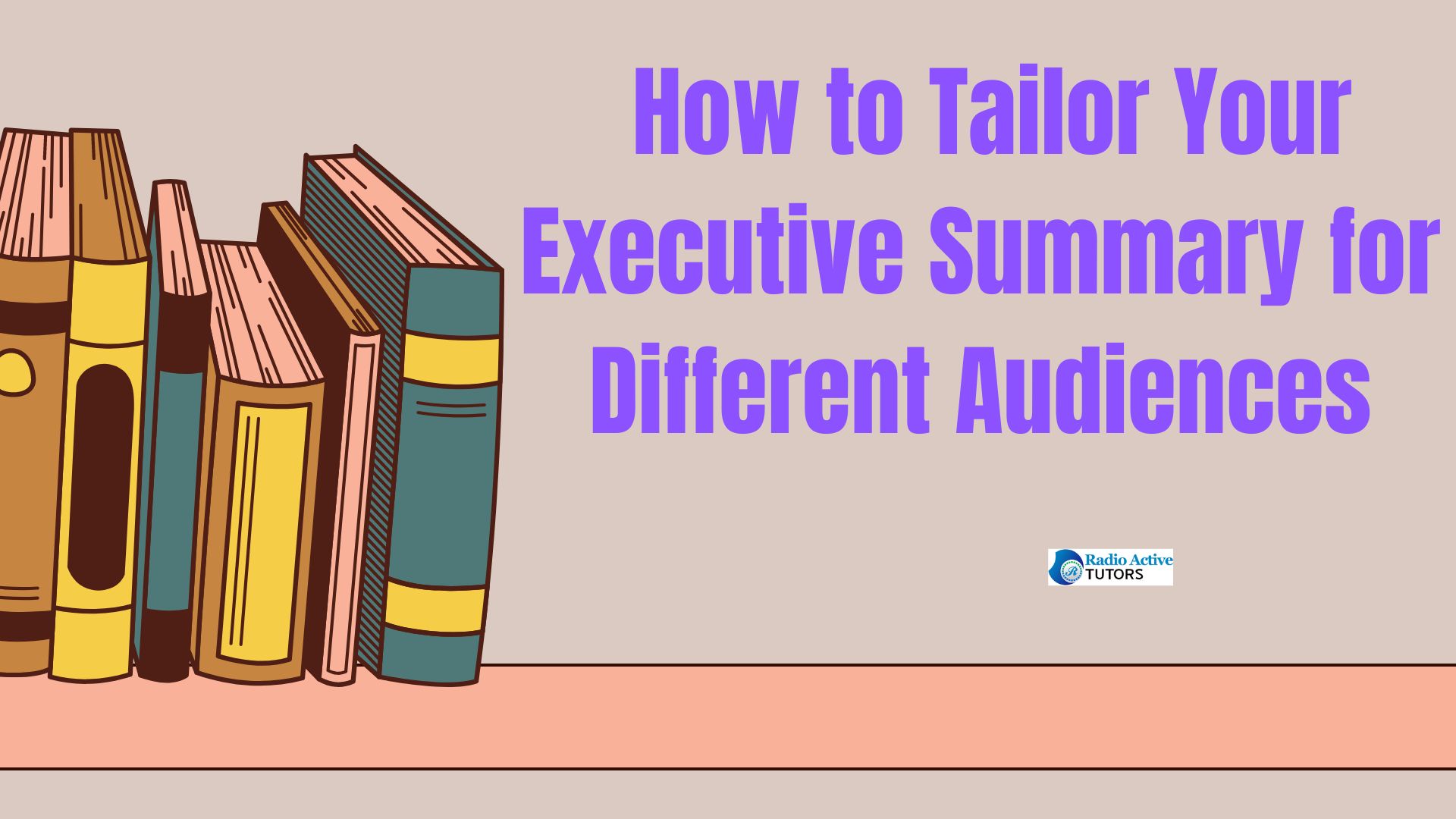Table of Contents
I. Introduction
II. Understanding the Purpose
III. Key Elements of an Executive Summary
IV. How to Structure an Executive Summary
V. Writing Tips for an Executive Summary
VI. Common Mistakes to Avoid
VII. Case studies of Well-Written Executive Summaries
VIII. How to Tailor Your Executive Summary for Different Audiences
IX. Best Practices for Presenting Your Executive Summary
X. Frequently Asked Questions (FAQs)
I. Introduction
- Importance of an Executive Summary

The importance of an executive summary in business cannot be overstated. It serves as a concise overview of a longer document, such as a business plan, report, or proposal, providing busy executives with a snapshot of the key points. Its role is crucial in conveying the main objectives, findings, recommendations, and financial projections of a project or business endeavor. A well-crafted executive summary not only saves time but also helps decision-makers quickly grasp the essence of the document, enabling them to make informed decisions and prioritize further reading. Its clarity and brevity make it an indispensable tool for effective communication within organizations and with external stakeholders, ensuring that crucial information is communicated efficiently.
- What is an Executive Summary?
An executive summary is a condensed version of a longer document that provides a brief overview of its main points. Typically found at the beginning of reports, proposals, or business plans, an executive summary aims to summarize the key elements of the document for its intended audience. It includes a synopsis of the purpose of the document, its main findings or recommendations, and any significant conclusions or strategic actions to be taken.
The executive summary is designed to be clear, concise, and informative, offering busy decision-makers a quick understanding of the document’s content without needing to read the entire text. It serves as a valuable tool for effective communication and decision-making within organizations and is crucial for stakeholders who need to grasp the essence of a project or proposal quickly.
II. Understanding the Purpose
- Purpose of an Executive Summary
The purpose of an executive summary is to provide a succinct and clear overview of the main purpose, findings, and recommendations of a longer document. It serves as a strategic tool to help busy executives and stakeholders quickly understand the essence of the document without having to read through all the details. By highlighting the key points and insights, an executive summary enables decision-makers to grasp the significance of the information presented and to make informed decisions based on the summarized content. It also acts as a bridge, guiding the reader to delve deeper into the full document if necessary, ensuring that the core message and implications are effectively communicated.
Ultimately, the executive summary plays a crucial role in enhancing communication, facilitating efficient decision-making processes, and ensuring alignment on key issues within organizations and among stakeholders.
- Differences Between an Executive Summary and an Abstract
The differences between an executive summary and an abstract lie primarily in their purposes and audiences. An executive summary is typically longer and more detailed than an abstract, providing a comprehensive overview of the main points, findings, and recommendations of a document, such as a report or proposal. It is tailored specifically for busy executives and decision-makers who need a quick understanding of the document’s content without reading the entire text. In contrast, an abstract is shorter and more concise, summarizing the key points of a research paper or academic article for an academic audience.
While both serve to provide a summary of the main content, an executive summary focuses more on practical implications and strategic recommendations, whereas an abstract highlights the academic relevance and methodology of the research. Therefore, the executive summary is more oriented towards business and practical applications, while an abstract is more academic in nature.
III. Key Elements of an Executive Summary

The problem statement is a crucial element of an executive summary, succinctly articulating the core issue or challenge that the document addresses. It serves to define the problem clearly and concisely, providing context for the reader to understand why the document or proposal is necessary. The problem statement should be brief yet comprehensive, outlining the scope and impact of the problem to demonstrate its significance. It sets the stage for the rest of the executive summary, guiding the reader towards the proposed solutions and recommendations that follow. By clearly defining the problem, the executive summary ensures that decision-makers understand the primary issue at hand and are prepared to consider the proposed strategies and actions outlined in the document.
The solution is a fundamental component of an executive summary, presenting the proposed approach or strategy to address the problem identified in the document. It outlines the key actions or recommendations intended to resolve the issue effectively. The solution should be clearly articulated, highlighting its feasibility, benefits, and anticipated outcomes. It may include strategic initiatives, operational changes, or specific projects that will contribute to overcoming the problem. The executive summary should succinctly convey how the proposed solution aligns with the organization’s goals and objectives, providing decision-makers with a clear understanding of the path forward. By outlining a well-defined solution, the executive summary enables stakeholders to assess the document’s value and make informed decisions about implementing the recommendations.
The market opportunity section in an executive summary highlights a specific area of potential growth or advantage that the document aims to capitalize on. It identifies and explains the opportunity within the market that the organization intends to pursue, emphasizing its relevance and significance. This section typically includes an analysis of market trends, customer needs, and competitive dynamics to support the identified opportunity. It may also outline the market size, growth potential, and target audience for the proposed solution.
The market opportunity section provides decision-makers with a clear understanding of the strategic direction and potential benefits of the initiative, ensuring alignment with the organization’s overall objectives. It serves to justify the proposed actions and strategies by demonstrating their potential to seize market opportunities and achieve sustainable growth.
Competitive analysis is a critical component of an executive summary, providing a concise overview of the competitive landscape relevant to the document’s subject matter. It includes an assessment of key competitors, their strengths and weaknesses, market share, and strategies. The competitive analysis in the executive summary helps decision-makers understand the organization’s position relative to its competitors, identifying opportunities and potential threats. By highlighting competitive advantages and challenges, it informs the strategic direction proposed in the document.
The analysis may also include insights into industry trends, customer preferences, and technological advancements that impact competitiveness. Overall, the competitive analysis in the executive summary serves to justify the proposed strategies and differentiate the organization’s approach in the marketplace, ensuring alignment with market realities and enhancing the document’s credibility.
Recommendations are a pivotal element of an executive summary, offering actionable suggestions derived from the analysis and findings presented in the main document. They outline specific courses of action or strategies that decision-makers should consider to address the identified problem or capitalize on opportunities. Recommendations in the executive summary should be clear, feasible, and directly linked to the insights and conclusions discussed. They are typically prioritized based on their potential impact and alignment with the organization’s goals and objectives.
The executive summary’s recommendations guide stakeholders on how to move forward, emphasizing the benefits and expected outcomes of implementing the proposed actions. This section ensures that decision-makers understand the steps required to achieve the desired results and provides a foundation for further discussion and planning.
IV. How to Structure an Executive Summary

The opening statement of an executive summary plays a crucial role in capturing the attention of the reader and setting the tone for the entire document. It should succinctly introduce the purpose and scope of the document, clearly stating the problem or opportunity being addressed. The opening statement should engage the reader by highlighting the significance of the issue and its relevance to the organization’s goals or objectives. It may also include a brief overview of the approach taken and the main findings or conclusions.
A well-crafted opening statement in the executive summary ensures that decision-makers understand the document’s purpose from the outset and encourages them to continue reading to gain a deeper understanding of the analysis and recommendations presented.
The section on the problem or opportunity in an executive summary provides a concise description of the core issue or potential benefit that the document addresses. It outlines the specific challenge or opportunity that prompted the need for the document, emphasizing its importance and relevance to the organization. This section should clearly define the problem or opportunity, providing sufficient context for the reader to understand its significance. It may include relevant data or statistics to underscore the magnitude of the issue or the potential benefits of pursuing the opportunity.
The problem or opportunity statement sets the stage for the subsequent analysis and recommendations, guiding the reader towards understanding the document’s purpose and the proposed solutions or actions to be considered. It ensures that decision-makers grasp the fundamental issue or opportunity at hand and are prepared to evaluate the document’s proposals effectively.
The proposed solution section of an executive summary presents the recommended approach or strategy to address the identified problem or capitalize on the opportunity outlined earlier in the document. It succinctly describes the actions, initiatives, or changes proposed to achieve the desired outcomes. This section should clearly articulate the benefits and advantages of the proposed solution, highlighting its feasibility and alignment with the organization’s goals. It may include key milestones or objectives to be achieved, as well as the expected impact on the organization or stakeholders.
The proposed solution section aims to convince decision-makers of the effectiveness and practicality of the recommended approach, providing a roadmap for implementation and indicating the potential outcomes if the suggestions are adopted. It ensures that stakeholders understand the proposed course of action and are equipped to make informed decisions based on the analysis and recommendations provided in the executive summary.
- Market and Competitive Analysis
The market and competitive analysis section of an executive summary provides a concise overview of the current market landscape and competitive environment relevant to the document’s subject matter. It includes an assessment of the industry trends, market size, growth potential, and key factors influencing market dynamics. Additionally, it evaluates the competitive landscape by identifying major competitors, their strengths and weaknesses, market share, and strategies. This section may also highlight any regulatory or technological factors that impact the market.
The market and competitive analysis in the executive summary aims to provide decision-makers with a clear understanding of the external factors influencing the organization’s position and opportunities in the market. It supports the proposed strategies by showing how they capitalize on market trends and competitive advantages, ensuring alignment with market realities and enhancing the document’s credibility and relevance.
The financial projections section of an executive summary presents a summary of the anticipated financial performance of the proposed initiative or business venture. It includes key financial metrics such as revenue forecasts, profitability projections, cost estimates, and funding requirements. This section may also highlight important financial assumptions and methodologies used in developing the projections. The financial projections provide decision-makers with a clear understanding of the financial implications and potential returns associated with the proposed solution.
It helps stakeholders assess the feasibility and profitability of the initiative, ensuring that they have the necessary information to make informed decisions. The financial projections section is crucial in demonstrating the financial viability and attractiveness of the proposed strategy, supporting the overall business case presented in the executive summary.
The call to action in an executive summary serves as the concluding section that prompts decision-makers to take specific steps based on the information presented in the document. It typically summarizes the key recommendations and encourages stakeholders to support or implement the proposed strategies. The call to action should be clear and persuasive, outlining the next steps and responsibilities. It may include a request for approval, funding, further discussion, or support for the proposed initiative.
The purpose of the call to action is to motivate decision-makers to move forward with the recommendations and to emphasize the potential benefits and outcomes of doing so. It ensures that the executive summary not only informs but also encourages action, guiding stakeholders towards making decisions that align with the organization’s goals and objectives.
V. Writing Tips for an Executive Summary

When crafting an executive summary, it’s essential to adhere to several key writing tips to ensure clarity, effectiveness, and impact. Begin by clearly stating the purpose and scope of the document in the introduction, providing context for the reader. Summarize the main points concisely, focusing on the problem statement, proposed solution, and key recommendations. Use bullet points or numbered lists to organize information and improve readability. Include relevant data, metrics, and examples to support your findings and proposals, ensuring they are compelling and evidence-based.
Maintain a professional and objective tone throughout, avoiding unnecessary jargon or technical language unless essential. Tailor the executive summary to your audience’s needs and preferences, emphasizing different aspects for various stakeholders. Finally, proofread and edit the summary carefully to ensure clarity, coherence, and correctness. By following these writing tips, you can create an executive summary that effectively communicates your message, engages your audience, and supports informed decision-making.
VI. Common Mistakes to Avoid
When preparing an executive summary, it’s crucial to avoid common mistakes that can undermine its effectiveness and impact. One common mistake is including too much detail. The executive summary should be concise and focused, highlighting the most critical aspects of the document without overwhelming the reader with unnecessary information. Another mistake is lacking clarity in the problem statement or proposed solution. It’s essential to clearly define the problem or opportunity and articulate a well-thought-out solution that aligns with the organization’s goals.
Additionally, some summaries fail to address the audience’s perspective. It’s important to tailor the executive summary to the needs and interests of the intended audience, ensuring that it resonates with their priorities and concerns. Lastly, neglecting to proofread and edit for clarity and coherence can diminish the professionalism of the document. By avoiding these common mistakes, you can create an executive summary that effectively communicates your message, engages your audience, and supports informed decision-making.
VII. Case studies of Well-Written Executive Summaries
Case studies of well-written executive summaries illustrate how effective communication and strategic thinking can influence decision-making and achieve organizational goals. These summaries typically begin with a clear and compelling introduction that succinctly states the purpose and scope of the document. They summarize key points concisely, focusing on the problem or opportunity, proposed solutions, and actionable recommendations. Well-written executive summaries often use bullet points or numbered lists to organize information for clarity and readability, while also including relevant data and metrics to support findings and proposals.
They are tailored to their audience, ensuring that stakeholders understand the document’s relevance to their roles and responsibilities. Finally, these summaries end with a strong call to action that clearly outlines next steps and encourages support for the proposed initiatives. Overall, case studies of well-written executive summaries demonstrate how strategic communication and effective summarization can lead to informed decision-making and successful outcomes.
VIII. How to Tailor Your Executive Summary for Different Audiences

Tailoring your executive summary for different audiences is essential to ensure relevance and effectiveness. Start by understanding the specific needs, interests, and priorities of each audience group. Customize the language and tone to resonate with their level of expertise and familiarity with the subject matter, avoiding unnecessary technical jargon for non-specialist audiences. Highlight the aspects of the document that are most relevant to each group, emphasizing different benefits or outcomes based on their concerns.
For example, emphasize financial metrics and ROI for executives and stakeholders focused on budgeting and resource allocation, while emphasizing strategic impact and market positioning for business development teams. Adjust the length and level of detail accordingly, providing more in-depth analysis for technical audiences and concise summaries for those who need a broader overview. By tailoring your executive summary to different audiences, you can ensure that each group understands the relevance of the document to their specific roles and responsibilities, thereby maximizing engagement and support for your proposals.
IX. Best Practices for Presenting Your Executive Summary
When presenting your executive summary, it’s crucial to follow best practices to ensure clarity, impact, and engagement with your audience. Begin with a compelling introduction that clearly states the purpose and significance of the document. Summarize the key points concisely, focusing on the problem or opportunity, proposed solution, and the expected outcomes. Use bullet points or numbered lists to organize information for easy readability and comprehension. Include relevant data and metrics to support your findings and recommendations, but avoid overwhelming your audience with excessive detail. Tailor your language to your audience, avoiding jargon and technical terms unless necessary. Use visuals such as charts or graphs to illustrate key points effectively.
End with a strong call to action that clearly outlines the next steps and encourages decision-makers to support or implement your recommendations. Finally, proofread carefully to ensure clarity and coherence throughout the document. Following these best practices will help you create an executive summary that effectively communicates your message and influences decision-making.
X. Frequently Asked Questions (FAQs)
- How long should an executive summary be?
- What should be included in an executive summary?
- How is an executive summary different from an abstract?
- Can an executive summary include visual aids?
- How often should an executive summary be updated?
- What are common mistakes to avoid?
- How do you make an executive summary persuasive?
- Should the executive summary be written first or last?
